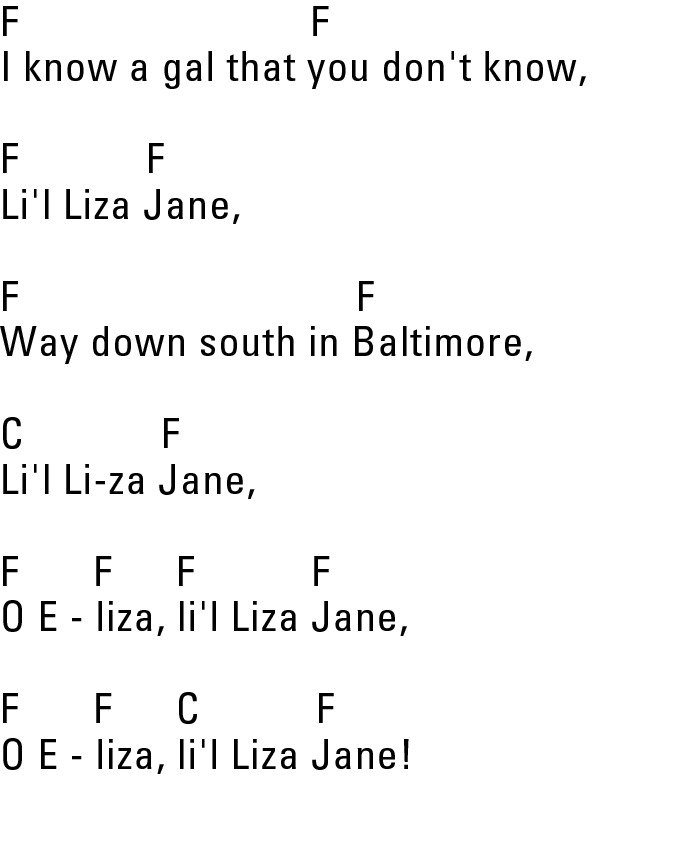Ukulele For Dummies (14 page)
Read Ukulele For Dummies Online
Authors: Alistair Wood

You want to play slow enough that the chord changes are smooth, not choppy. Avoid strumming up to tempo, stopping at the chord changes and then carrying on at tempo. You want to practise keeping a steady beat throughout the song. Imagine that you're playing for someone (or millions of adoring fans if you prefer) who's tapping his foot along with your song. You want the person to be able to keep tapping his foot at the same speed straight through the chord changes.
Figure 4-7:
âLi'l Liza Jane' simple chord chart.

Developing Your First Strumming Patterns
After you get the basics of your first song down (as I describe in the preceding section), you're going to want to fancy things up a bit with some strumming.
No single right way exists to strum any particular song, but you have to make sure that the strumming pattern fits the song and emphasises the right beats.
Using strumming notation
Like chord diagrams,
strumming notation
is an easy-to-read shorthand that gives you just the information you need to play.
The notation is presented on a musical
stave
, but it doesn't show the individual notes the way that standard musical notation does. Instead you just get
chord slashes
,
which show a vertical line for each time you strum. Take a look at Figure 4-8.
Figure 4-8:
Down-down-down-down strum notation.

The main parts in a chord notation diagram are as follows:
 The lines with a little tick at the top are slashes.
The lines with a little tick at the top are slashes.
Each time you see one of those you strum.
 The slashes are divided into groups.
The slashes are divided into groups.
To make the music easy to follow, the music is divided into groups known as bars.
 The chord names (in this case, F and C) are directly above the first slashes
The chord names (in this case, F and C) are directly above the first slashes
. You play the same chord for each slash until you come to the next chord name.
 The count (âone, two, three, four') is immediately below each slash.
The count (âone, two, three, four') is immediately below each slash.
Counting these off (out loud or in your head) helps you to maintain the rhythm.
 The strumming direction is below the count.
The strumming direction is below the count.
A little letter âd' means down and a little letter âu' means up. In Figure 4-8, all the markings are âd' for down.
Filling in with ups and downs
You can make your strums much more interesting by putting some up strums between the down strums. You're already moving your hand up and down, so you may as well make use of it.
 Take a look at Figure 4-9, which relates to Track 2, to see how up strums look in slash notation. Where you see two notes grouped together, you do a down-up strum.
Take a look at Figure 4-9, which relates to Track 2, to see how up strums look in slash notation. Where you see two notes grouped together, you do a down-up strum.
Figure 4-9:
Down-down-up strum.

For the pattern shown in Figure 4-9, you strum down, and then you strum down-up and repeat that pattern. Don't worry about the chord changes for now. Get that strumming pattern under your fingers before you move on. To really get into the rhythm, clap it out before even trying to strum it.
The down-up strum as a whole takes up the same amount of time as a single down strum. The down strum is a
whole beat
and each part of the down-up strum is
half a beat
. You can count these off by adding âand' between counts. In this case, you'd say âone two and three four and'.
You don't have to change the strum from Figure 4-8 much to play the down-down-up pattern. You already have to bring your hand up for the next down strum. All you need to do is hit the strings with the pad of your index finger when you bring your hand up.
Finding an easy way to follow rhythms
Mnemonics
are a great way to get your timing right when you're playing. Instead of counting âone, two, three' and so on, you use words that match the length of the strum.
You can use any set of words that fit. At school we used drink names but my brain has difficulty processing anything that doesn't involve ukes so I use ukulele names. Two such names that work well here are Flea and Kala (pronounced like the name Carla).
So here are a couple of the strums that I use:
 Down strum (whole beat)
Down strum (whole beat)
=
Flea